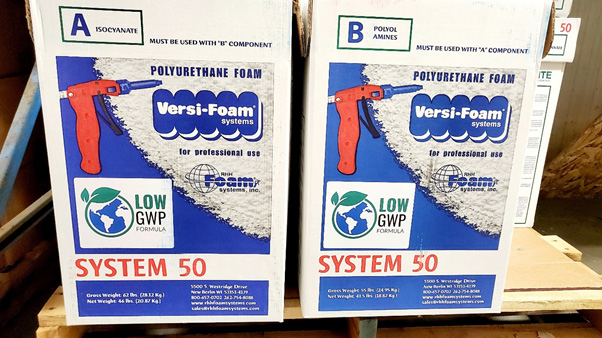Thermal Insulation with Versi-Foam Systems
Versi-Foam thermal insulation spray kits
Bellis Australia is the official distributor of Versi-Foam Spray Foam Kit in Australia. Versi-Foam is one of our most versatile product and you can use it in most applications where you need thermal insulation. It is the top choice for our customers, especially insulation professionals and contractors. The Versi-Foam two-component expandable polyurethane system is self-contained so you don’t need an outside power source to use it.
Some of the benefits of Versi-Foam include the following:
- Each kit comes pre-pressurised with an easy to use U-control gun, hose assembly, and dispensing nozzles
- The thermal foam insulation can get to the hard to reach areas that fibreglass insulation can’t reach
- Versi-Foam has moisture and mould resistance factors
- The spray foam creates an airtight thermal seal
- Makes the structure more stable and durable
- Curing time takes 5 to 10 minutes depending on the temperature (Carefully read manufacturer’s manual before use!)
You can use Versi-Foam Systems Disposable Foam Kit for many applications. These include general construction, metal building insulation and sealing, roofing, residential construction, transportation insulation, and marine applications like floatation devices. For the maintenance in industrial settings, Versi-Foam provides pipe and fitting insulation along with duct and tank insulation, condensation control, and sealing of air and dust.
Before using Versi-Foam Polyurethane Spray systems over electric cables and plastic piping, check compatibility of the electric cables and plastic piping for use with Polyurethane Spray Foam systems from the suppliers and manufacturers of electric cables and plastic pipes and seek professional advice before proceeding.
Bellis Versi-Foam HFC To HFO Transition:
Hydrofluorocarbons (HFCs) are a type of synthetic greenhouse gas, mostly used in refrigeration, air-conditioning equipment and also used as a foam blowing agent.
HFCs generally have a high global warming potential (GWP) which means they have a greater ability to trap heat in the atmosphere compared to a similar mass of carbon dioxide (CO2).
For example, the release of one tonne of HFC 23 (which has a GWP of 14,800) is equivalent to releasing 14,800 tonnes of CO2 into the atmosphere.

International HFC phase-down:
Representatives from Australia and most of the other 196 countries that are parties to the Montreal Protocol reached a global agreement on reducing hydrofluorocarbon (HFC) emissions when they met in Kigali, Rwanda, from 10 to 14 October 2016.
The Meeting of the Parties agreed to an international phase-down of global HFC production and imports. The agreement will see an 85 per cent phase-down in developed countries by 2036, an 80 per cent phase-down by 2045 in most developing countries including China, and the remaining developing countries reaching an 85 per cent phase-down by 2047.
The HFC phase-down is a gradual reduction in the maximum amount of bulk HFCs permitted to be imported into Australia, which started on 1 January 2018. It is managed through a quota system on imports.
A phase-down schedule was developed for Australia, in consultation with industry, to meet Montreal Protocol requirements. Australia’s phase-down has regular, smaller step-downs than the Montreal Protocol requirements. The annual starting limit of HFC imports was 8.0 million tonnes CO2-emissions. The 15% residual import limit from 2036 is 1.607 million tonnes CO2-emissions. This residual import limit will be an ongoing import limit.

Bellis Versi-Foam HFC To HFO Transition:
In industrial applications, HFC’S are widely used as a foam blowing agent for spray foams. Blowing agent technology has evolved over the last few decades, greatly reducing environmental impact. Fourth generation blowing agents based on Hydrofluoroolefin (HFO) technology have reduced the GWP to be equivalent with CO2.
Bellis Australia being one of the major suppliers of foam insulation products which are environmentally friendly and comply with the government regulations, we initiated to use HFO’S instead of using HFC’S.

Our VERSI FOAM products are formulated with an ultra-low global warming potential blowing agent based on HFO technology which has very low GWP, HFC-free and has very little impact on the ozone layer which is equivalent to the impact of CO2.
Bellis Australia’s new Versi-foam with HFO Blowing agent has better performance and applications as the previously supplied Versi-foam with HFC’S as blowing agent. The Versi-foam with HFO blowing agent has better thickness, high R-values, and better thermal resistance. The new HFO blowing agent-based Versi-foams are compared to the older generation foams, the thermal conductivity is 25% better, the product is more stable over time, the shrinkage is minimized, and the density of the foam is 13% lower compared to water-based ones.
Storage Requirements:
- Never store VersiFoam® products at temperatures lower than 40°F (5°C). Storing at these temperatures may cause the chemicals to freeze.
- Always warm the chemicals to a temperature between 65°F to 90°F (18°C to 32°C) before using.
- Refer to the temperature sensing strip on the box to be sure it is well within the green zone. During application, warm the chemicals again if the strip begins to move toward the blue zone.
- Bring your VersiFoam® kits into a warm space for at least 24 hours prior to use. After warming the chemicals, be sure to shake the tanks well to ensure a uniform temperature throughout.
- Always warm the surface where you’re applying the foam to a temperature between 65°F to 90°F (18°C to 32°C).
For Versi-foam specifications and any other information, please visit the Versifoam website.
Bellis Australia is the approved supplier of Versi foam from RHH foam systems in Australia.
Please contact Bellis Australia at 1300 740 564 for our new environmentally friendly insulation products.
